Glorious Days in Sutherland
- Details
- Published on Saturday, 15 October 2011 07:56
- Written by Anthony Glasgow
 The summer of 2011 was full of glorious days in Sutherland. I was fortunate to have three visits to Assynt; long weekends in June and July, a week in September and each exceeded expectation, for not only was the fishing wonderful, but for the most part the weather was kind, the midges absent and the scenery – as always – majestic.
The summer of 2011 was full of glorious days in Sutherland. I was fortunate to have three visits to Assynt; long weekends in June and July, a week in September and each exceeded expectation, for not only was the fishing wonderful, but for the most part the weather was kind, the midges absent and the scenery – as always – majestic.
In each case I had good company and we rough-camped in order to explore some of the more remote lochs in the area and to spend longer by the lochside than we would have done had we had to make it back for supper at a hotel or guest house.
I just love the rugged splendour of Assynt, the wildness and quantity of its lochs and the sheer majesty of its bare-rocked peaks. I have yet to land any glass-case fish and I accept that a trout of over a pond and a half is a specimen in these relatively sterile waters. Whilst I have caught a great number of fish on my visits over the years, I have to confess that the number I have caught over a pound is modest. But for me Assynt is not about the pursuit of large fish (unless you are after ferox) – it is about wild fishing for very wild trout and what’s not to like about that?
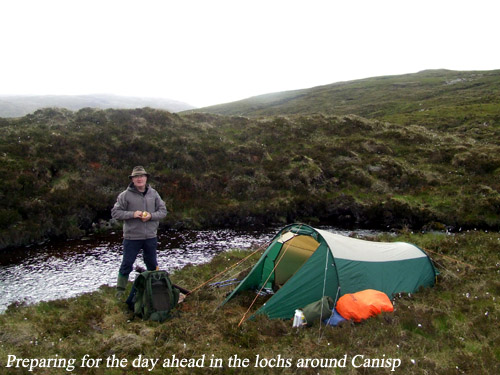 My trip in June with Sean Elliott coincided with bright clear weather and unseasonably cold nights – which certainly took my Cambridgeshire based companion by surprise. On one memorable morning we crept out of our tent (a trusty old Ultimate Peapod) to be met by a ground frost, but thankfully the day warmed quickly. Possibly as a result of the cool nights, we were blessed by a complete lack of midges on this trip which allowed us to relax and take our time over our cooking, camp admin and our fishing – so we had a wonderful break from the rigours of our modern lives.
My trip in June with Sean Elliott coincided with bright clear weather and unseasonably cold nights – which certainly took my Cambridgeshire based companion by surprise. On one memorable morning we crept out of our tent (a trusty old Ultimate Peapod) to be met by a ground frost, but thankfully the day warmed quickly. Possibly as a result of the cool nights, we were blessed by a complete lack of midges on this trip which allowed us to relax and take our time over our cooking, camp admin and our fishing – so we had a wonderful break from the rigours of our modern lives.
We fished to the west of the A835 in the area to the north of Canisp and had a great time tempting the local finned residents out of their natural habitat with a variety of traditional wet flies and dry sedge patterns. The changing wind, light and temperature and the differences between lochs ensured that there was a satisfactory variety to the fishing and we found the hours passing in an instant. My diary notes that we caught a total of 189 trout with our best at ¾ lbs but of much greater import was the fun we had in their capture and rapid release. If you are wondering how I can give such an accurate figure for the number of trout caught – it’s because Sean and I are sad enough to have ‘clickers’ for recording fish caught to alleviate the issue of our rapidly approaching dementia.
However much we like to record our catch, we are anything but obsessed by the 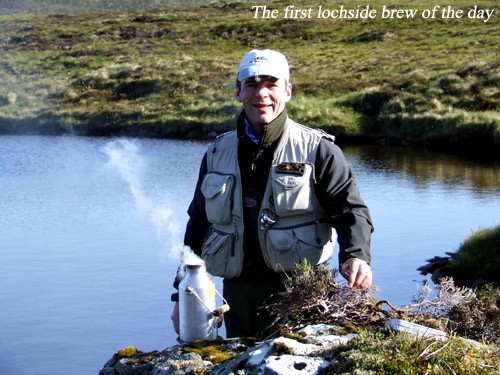 numbers game and, if I am absolutely honest, the most fun I had in the whole trip was extracting a number of very modest trout out of the Feith an Leothaid burn whilst on our way to fish Loch a Ghlinnean and Loch Feith an Leothaid. Small the trout most certainly were, but their capture involved us in stealthy commando approaches to likely holding pools and the fun of sight fishing so that we were able to see their terrier-like pursuit of our flies fished nymph style down the shallow burn. If you can’t see what I found fun about this, then perhaps this style of fishing isn’t for you!
numbers game and, if I am absolutely honest, the most fun I had in the whole trip was extracting a number of very modest trout out of the Feith an Leothaid burn whilst on our way to fish Loch a Ghlinnean and Loch Feith an Leothaid. Small the trout most certainly were, but their capture involved us in stealthy commando approaches to likely holding pools and the fun of sight fishing so that we were able to see their terrier-like pursuit of our flies fished nymph style down the shallow burn. If you can’t see what I found fun about this, then perhaps this style of fishing isn’t for you!
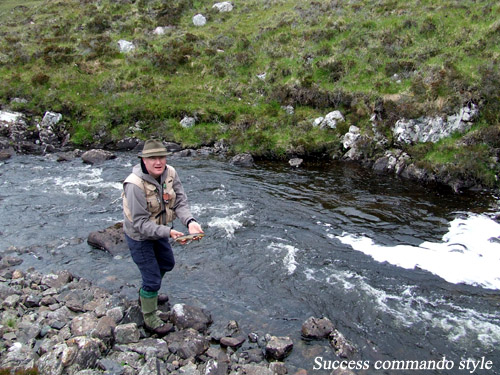
July saw me return to fish in the area of Suilven. After a short ‘up and over’ walk from the road to the bank of Lochan Fada, Stewart Eastaugh and I set our base camp and from there we walked and cast our lines in almost every compass direction. Whilst Lochan Fada did not give up its treasures as readily as it had to me the previous year, the fighting qualities of its half-pounders was more than satisfactory. The highlight of this trip was fishing the lochans in the very shadow of Suilven’s western buttress. Rarely fished and captivating in character, these lochs provided us with a special and successful day.
Again, our successful arsenal was based on traditional 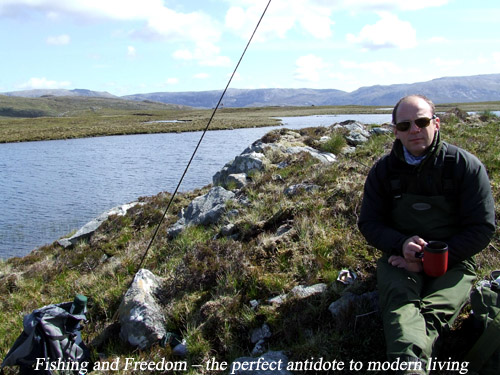 wet flies (claret bumble, bibio and black pennell were the pick of mine) and dry sedge patterns (is there a better dry fly for wild Scottish trout?). Old lessons were re-learnt as we found the vast majority of fish lying close in to the rugged banks of the lochs and so a stealthy approach and casts made along the bank provided repeated success. It’s that old fishing conundrum, why is it that bank anglers spend all their time trying to cast as far into the loch as possible and boat anglers try to put their fly as close in to the bank as they can? Do we ever learn? Well, I hope so as we were given plenty of empirical evidence in the 178 trout caught on our trip.
wet flies (claret bumble, bibio and black pennell were the pick of mine) and dry sedge patterns (is there a better dry fly for wild Scottish trout?). Old lessons were re-learnt as we found the vast majority of fish lying close in to the rugged banks of the lochs and so a stealthy approach and casts made along the bank provided repeated success. It’s that old fishing conundrum, why is it that bank anglers spend all their time trying to cast as far into the loch as possible and boat anglers try to put their fly as close in to the bank as they can? Do we ever learn? Well, I hope so as we were given plenty of empirical evidence in the 178 trout caught on our trip.
Throughout our time in these remote parts we were constantly reminded that we were mere interlopers in a wild landscape, for wildlife was all around unlike fellow homo sapiens. Another perfect antidote to our busy working lives.
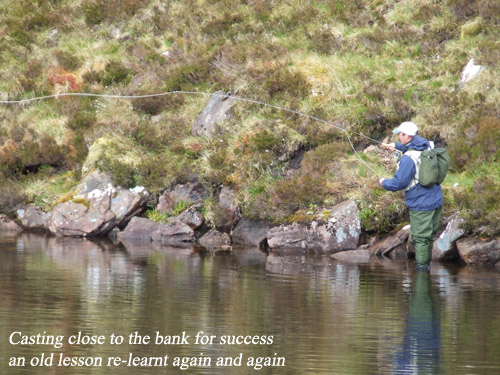 If these first two excursions had been blessed with great weather, my week in September with Sean to explore the remote lochs in the region of Glen Coul was nothing if not a triumph over adversity. The fishing proved successful with over 260 fish taken to our rods in the week but, frankly, it was a very damp affair which called upon all our reserves of good humour and sound admin to ensure morale was maintained. But maintained it was and we are both still looking back on the week fondly for having enjoyed overcoming the climatic challenge.
If these first two excursions had been blessed with great weather, my week in September with Sean to explore the remote lochs in the region of Glen Coul was nothing if not a triumph over adversity. The fishing proved successful with over 260 fish taken to our rods in the week but, frankly, it was a very damp affair which called upon all our reserves of good humour and sound admin to ensure morale was maintained. But maintained it was and we are both still looking back on the week fondly for having enjoyed overcoming the climatic challenge.
The approach walk was long and not for the casual hill walker – the tough broken terrain in the area of Ben More Assynt does not make for easy travel with a heavy pack but it did succeed in taking us to very remote fishing venues which we hoped would increase our chances of connecting with better than average fish.
Our remote venues did not, in the main, disappoint – only one morning was spent without any result at all – and in two lochs we caught a far better stamp of trout (up to 2lbs) which perhaps vindicated our decision to travel some six hours walk into the wilderness. We fished Gorm Loch Mor and its satellites before moving on to Loch nan Caorach and Loch an Eircill as well as the even more remote lochs to the north of Glen Coul – all absolutely wonderful lochs full of piscatorial intrigue.
Other than the first two days it rained constantly, so we were fortunate to have with us good waterproofs and a sound tent (on this occasion a very modestly-priced Blacks Constellation series) – although we did have to treble-line the tent poles one night as the high winds threatened to remove our home. Our decision to carry-in good hearty provisions was also vindicated, as good food and a welcome dram in the evening were instrumental in keeping spirits up – especially as with being later in the year it was dark from 9pm which gave us far longer in the tent than in June and July. 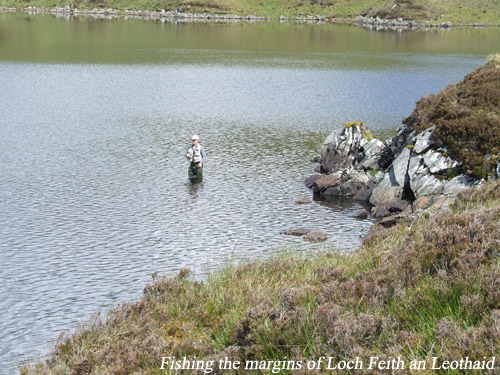
The fishing, most of which was conducted in high winds and relentless rain, was challenging but we persevered and in most of the lochs we fished I am glad to say that we found fish-holding areas and the pattern of fly that the trout were happy to attack. With the weather as it was, our dry fly boxes sadly stayed shut and on this trip we were forced to stick to wet flies. This I found mildly frustrating as I have been fishing dries more and more often in highland lochs with exciting results and as much as I remain essentially a ‘wet-fly enthusiast’ I have found that dries seem to bring up the better fish.
All too soon our trip came to an end and we walked back out over peat hag and rock, our packs now marginally lighter (yes, we had lightened the load by eating and drinking our provisions – but sadly the amount of water now on/in our kit almost made up the difference) and despite the effort of lugging heavy packs over such a distance we had most certainly enjoyed our time in Sutherland again.
Roll on 2012…!
Anthony Glasgow is a lifelong and passionate fisherman, in particular for wild brown trout. Retired from the Royal Engineers as a major in 2004, aged 38 having served in UK, Germany,Canada, Northern Ireland, Bosnia and the Gulf. Now working in Perthshire (where good hillwalking and fishing is but minutes away – coincidence?). Despite his diminutive build, was once considered a good rugby player, but now fishing takes priority whenever he has the time!

